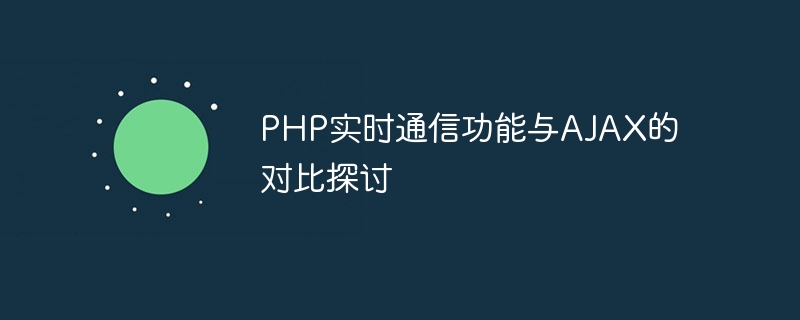

Comparative discussion between PHP real-time communication function and AJAX
With the rapid development of the Internet, real-time communication has become one of users' expectations for websites and applications. In the past few years, PHP and AJAX have been widely used for real-time communication functions. However, these two technologies have different methods and advantages when implementing real-time communication functions. This article will compare and discuss the real-time communication function of PHP and AJAX, and give some code examples.
1. PHP real-time communication function
In PHP, commonly used real-time communication technologies include WebSockets and Long Polling. WebSockets is a full-duplex communication protocol that allows real-time data transfer between clients and servers. Long polling is a technology that simulates real-time communication by continuously sending requests and waiting for the server to return results.
The following is an example of PHP code that uses WebSockets to achieve real-time communication:
// 创建WebSocket服务器
$server = new WebSocketServer('localhost', 8080);
// 处理连接事件
$server->on('connection', function ($conn) {
// 处理接收到的消息
$conn->on('message', function ($message) use ($conn) {
// 处理消息
$conn->send($message);
});
});
// 启动服务器
$server->run();The above code creates a WebSocket server to achieve real-time communication by listening to connection events and message events. When a new connection is established, the server will call the callback function that handles the connection event. When a message is received, the server will call the callback function that handles the message.
2. AJAX real-time communication
AJAX is a technology that communicates asynchronously with the server without reloading the entire web page. Common methods of using AJAX to achieve real-time communication include polling and Comet.
The following is a code example that uses AJAX polling to achieve real-time communication:
function getData() {
$.ajax({
url: 'getData.php',
success: function(data) {
// 处理返回的数据
console.log(data);
// 继续轮询
setTimeout(getData, 1000);
}
});
}
// 启动轮询
getData();The above code uses jQuery's AJAX method to send requests and continuously obtains the latest data through polling. . When the request is successful, process the returned data and continue to initiate the next request.
3. Comparison and summary
PHP real-time communication function and AJAX have their own advantages and applicable scenarios. PHP real-time communication function can transmit data in real time with low latency and resource consumption through WebSockets and long polling technology. However, the PHP real-time communication function requires additional server resource support and may not be efficient enough for large-scale real-time communication applications.
In contrast, AJAX achieves real-time communication through polling and Comet methods, does not require additional server resource support, and is suitable for smaller-scale real-time communication applications. However, AJAX polling results in frequent requests and responses, increasing the load on the server.
In short, whether to choose PHP real-time communication function or AJAX needs to be decided according to the specific application scenarios and needs. If you need high-performance, large-scale real-time communication applications, it is recommended to use the PHP real-time communication function; if you need small-scale real-time communication applications, AJAX is a simpler and more flexible choice.
The above is a comparative discussion of PHP's real-time communication function and AJAX, showing their usage, advantages and disadvantages through code examples. When choosing real-time communication technology, you need to make the appropriate choice based on specific needs and scenarios.
The above is the detailed content of Comparison between PHP real-time communication function and AJAX. For more information, please follow other related articles on the PHP Chinese website!